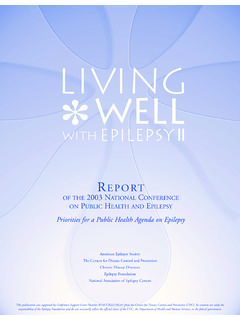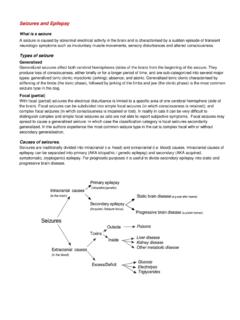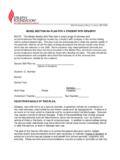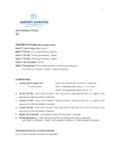Transcription of Programme for Neurological Diseases and …
1 1 Programme for Neurological Diseases and NeuroscienceDepartment of Mental health and Substance AbuseWorld health OrganizationGenevaGlobal Campaign Against Epilepsy2 WHO Library Cataloguing-in-Publication DataWorld health : epilepsy Care in the epidemiology therapy care surveys health services statistics : Atlas of epilepsy care in the world . ISBN 92 4 156303 6 (NL classification: WL 385) world health organization 2005 All rights reserved. Publications of the world health organization can be obtained from WHO Press, world health organization , 20 Avenue Appia, 1211 Geneva 27, Switzerland (tel: +41 22 791 2476; fax: +41 22 791 4857; email: Requests for permission to reproduce or translate WHO publications whether for sale or for noncommercial distribution should be addressed to WHO Press, at the above address (fax: +41 22 791 4806; email: The designations employed and the presentation of the material in this publication do not imply the expression of any opinion whatsoever on the part of the world health organization concerning the legal status of any country, territory, city or area or of its authorities, or concerning the delimitation of its frontiers or boundaries.))
2 Dotted lines on maps represent approximate border lines for which there may not yet be full mention of specific companies or of certain manufacturers products does not imply that they are endorsed or recommended by the world health organization in preference to others of a similar nature that are not mentioned. Errors and omissions excepted, the names of proprietary products are distinguished by initial capital reasonable precautions have been taken by the world health organization to verify the information contained in this publication. However, the published material is being distributed without warranty of any kind, either express or implied. The responsibility for the interpretation and use of the material lies with the reader. In no event shall the world health organization be liable for damages arising from its in Designed by Tushita Graphic Vision S rl, CH-1226 Th nexFor further details on this project or to submit updated information, please contact:Dr L.
3 Prilipko Programme Leader Neurological Diseases and Neuroscience Department of Mental health and Substance Abuse world health organization Avenue Appia 20, CH-1211 Geneva 27, Switzerland Tel: +41 22-791 36 21, Fax: +41 22-791 4160, e-mail: epilepsy is one of the most common serious disor-ders of the brain, affecting about 50 million people world -wide. epilepsy accounts for 1% of the global burden of disease ; 80% of the burden of epilepsy is in the developing world , where in some areas 80 90% of people with epilepsy receive no treatment at all. It is imperative to recognize that epilepsy consists of more than seizures for the affected individual and immediate effects on his or her family. epilepsy leads to multiple interacting medical, psychological, economic and social repercussions, all of which need to be considered in order to understand fully the impact of this condition.
4 Fear, misunderstanding and the resulting social stigma and discrimination surrounding epilepsy often force people with this disorder into the shadows .The world health organization (WHO) is responsible for providing technical information and advice to its Member States to help them to improve the health of their citizens. This task is facilitated by collaboration with various scientific and professional groups that have similar goals. To bring epilepsy out of the shadows , a Global Campaign Against epilepsy was launched in 1997 to improve acceptability, treatment, services and prevention of epilepsy worldwide . The Campaign is conducted by WHO in partnership with the International League Against epilepsy (ILAE) and the International Bureau for epilepsy (IBE). The aim of the Campaign is principally to reduce the treatment gap by providing better information about epilepsy and its conse-quences and to assist governments and those concerned with epilepsy to reduce the burden of the disorder.
5 To gather information about the resources available for epilepsy care in countries, the Atlas: epilepsy Care in the world was initiated. This Atlas represents a unique collaborative effort between WHO and the two leading nongovernmental organizations working in the field of results obtained from the study of country resources for epilepsy confirm that the available resources for epilepsy care in the world are insufficient when set against the large numbers of people needing such care and the known sub-stantial burden associated with this disorder. In addition, there are large inequities across regions and income groups of countries, with low-income countries having extremely meagre resources. Since the prevalence of epilepsy is much higher and resources are much scarcer in low-income coun-tries, the data reinforce the need for urgent, substantial and systematic action to enhance resources for epilepsy care in these countries.
6 It is hoped that the availability of essential information will lead to greater awareness among policy-makers of the gaps in resources for epilepsy care. The information is likely to assist health planners and policy-makers to identify areas that need urgent attention and to plan the upgrading of resources in those areas. The data will also serve as a baseline for monitoring the improvement in availability of resources for epilepsy care. We hope that personnel involved in caring for people with epilepsy , including health professionals and nongovernmental organizations, will use the Atlas data in their efforts to ensure more and better resources for epilepsy care. Dr Benedetto Saraceno Director Department of Mental health and Substance Abuse world health OrganizationProfessor Giuliano Avanzini President International League Against EpilepsyMr Philip Lee President International Bureau for Epilepsy4 Acknowledgements.
7 6 Preface.. 7 Executive summary.. 8 Introduction.. 11 Methodology .. 12 epilepsy : the disorder.. 15 1. Milestones in the history of epilepsy .. 16 2. Number of people with epilepsy .. 20 3. Epidemiology.. 22 4. Aetiology of epilepsy reported frequency .. 24 5. Aetiology and risk factors .. 26 epilepsy : the services.. 29 6. Diagnostic services.. 30 7. Primary care.. 32 8. Provision of care.. 34 9. Inpatient care.. 36 10. epilepsy specialist services .. 38 11. Antiepileptic drugs.. 40 12. The treatment gap.. 42 13. Sub-specialized services .. 44 14. epilepsy surgery.. 46 CONTENTS55 epilepsy : the care providers.. 49 15. Medical professionals.. 50 16. Professionals allied to medicine .. 52 17. Training in epileptology .. 54 18. Education in epileptology.
8 56 19. Professional associations.. 58 20. Lay associations .. 60 21. Role of ILAE in fostering epilepsy care .. 62 22. Role of IBE in providing epilepsy care.. 64 epilepsy : the public health aspects .. 67 23. Budget and financing.. 68 24. Disability benefits.. 70 25. epilepsy and rights.. 72 26. Reporting and data collection.. 74 27. Problems encountered .. 76 28. Stigma and social issues .. 78 29. The attributable and advertable burden of epilepsy .. 80 30. Global Campaign Against epilepsy .. 82 Glossary of terms.. 84 References .. 86 List of Respondents .. 90 CONTENTS6 ACKNOWLEDGEMENTS The Atlas: epilepsy Care in the world is one of the most important projects within the framework of the ILAE/IBE/WHO Global Campaign Against epilepsy (GCAE) Out of the Shadows , representing a major collaborative effort involving WHO headquarters, regional and country offices and ILAE and IBE headquarters and their members.
9 The work was supervised and coordinated by Dr Leonid Prilipko and Dr Shekhar Saxena at WHO headquarters and Mrs Hanneke de Boer, Co-Chair, GCAE Secretariat. Dr Benedetto Saraceno provided vision and guidance to the project and Dr Giuliano Avanzini and Mr Philip Lee provided their continuous support to the Campaign. Dr Tarun Dua was responsible for completion of the data collection, data analyses and overall project management and for most of the writing of this report. Dr Harry Meinardi and Dr Gus Baker provided technical guidance and supervi-sion. Dr Jerome Engel Jr, Dr Aleksandar Janca, Mr Philip Lee and Dr Harry Meinardi were involved in the development of the survey design and questionnaire. Ms Kathy Fontanilla was involved in the data management. Collaborators from WHO regional offices include: Dr Custodia Mandlhate and Dr Ther se Agossou, African Regional Office; Dr Claudio Miranda and Dr Jose Miguel Caldas de Almeida, Regional Office for the Americas; Dr Vijay Chandra, South-East Asia Regional Office; Dr Wolfgang Rutz and Dr Matthijs Muijen, European Regional Office; Dr Ahmed Mohit and Dr R.
10 Srinivasa Murthy, Eastern Mediterranean Regional Office; and Dr Helen Hermann and Dr Xiangdong Wang, Western Pacific Regional Office, all of whom made valuable contri-butions during the development of the project, the identi-fication of key persons in the area of epilepsy in Member States, and the review of the information from various countries, areas or territo-ries was provided by key persons working in the field of epilepsy identified by ILAE, IBE, WHO regional offices and the offices of WHO Representatives. Key collabora-tors who helped in the identification of key persons in the area of epilepsy in some of the countries include Dr Carlos Acevedo, Dr Amadou Gallo Diop, Dr Peter Halasz, Dr Shi Chuo Li and Dr Susan Spencer. The survey respondents handled the many requests for clarification arising from the data.
















